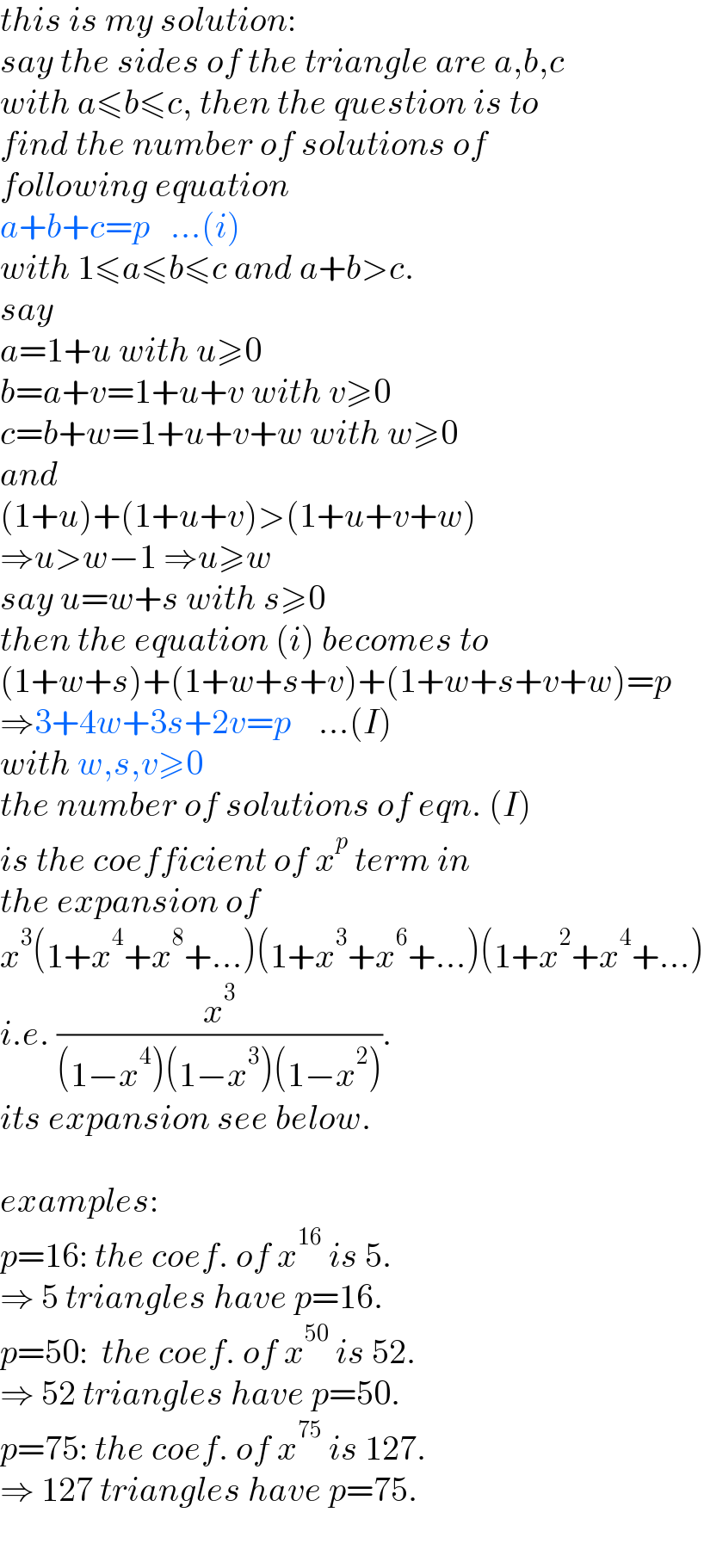Question Number 188301 by mr W last updated on 28/Feb/23

$${Find}\:{the}\:{number}\:{of}\:{triangles}\:{with} \\ $$$${integer}\:{side}\:{lengths}\:{and}\:{perimeter}\:{p}. \\ $$
Commented by mr W last updated on 28/Feb/23

$${as}\:{Q}\mathrm{188239},\:{but}\:{in}\:{general}\:{case}. \\ $$
Commented by BaliramKumar last updated on 27/Feb/23

$${why} \\ $$
Commented by mr W last updated on 27/Feb/23

$${for}\:{more}\:{solutions}! \\ $$
Commented by mr W last updated on 27/Feb/23

$${if}\:{you}\:{have}\:{a}\:{solution},\:{please}\:{share}. \\ $$
Answered by mr W last updated on 04/Mar/23

$${this}\:{is}\:{my}\:{solution}: \\ $$$${say}\:{the}\:{sides}\:{of}\:{the}\:{triangle}\:{are}\:{a},{b},{c} \\ $$$${with}\:{a}\leqslant{b}\leqslant{c},\:{then}\:{the}\:{question}\:{is}\:{to}\: \\ $$$${find}\:{the}\:{number}\:{of}\:{solutions}\:{of}\: \\ $$$${following}\:{equation} \\ $$$${a}+{b}+{c}={p}\:\:\:…\left({i}\right) \\ $$$${with}\:\mathrm{1}\leqslant{a}\leqslant{b}\leqslant{c}\:{and}\:{a}+{b}>{c}. \\ $$$${say} \\ $$$${a}=\mathrm{1}+{u}\:{with}\:{u}\geqslant\mathrm{0} \\ $$$${b}={a}+{v}=\mathrm{1}+{u}+{v}\:{with}\:{v}\geqslant\mathrm{0} \\ $$$${c}={b}+{w}=\mathrm{1}+{u}+{v}+{w}\:{with}\:{w}\geqslant\mathrm{0} \\ $$$${and} \\ $$$$\left(\mathrm{1}+{u}\right)+\left(\mathrm{1}+{u}+{v}\right)>\left(\mathrm{1}+{u}+{v}+{w}\right) \\ $$$$\Rightarrow{u}>{w}−\mathrm{1}\:\Rightarrow{u}\geqslant{w} \\ $$$${say}\:{u}={w}+{s}\:{with}\:{s}\geqslant\mathrm{0} \\ $$$${then}\:{the}\:{equation}\:\left({i}\right)\:{becomes}\:{to} \\ $$$$\left(\mathrm{1}+{w}+{s}\right)+\left(\mathrm{1}+{w}+{s}+{v}\right)+\left(\mathrm{1}+{w}+{s}+{v}+{w}\right)={p} \\ $$$$\Rightarrow\mathrm{3}+\mathrm{4}{w}+\mathrm{3}{s}+\mathrm{2}{v}={p}\:\:\:\:…\left({I}\right) \\ $$$${with}\:{w},{s},{v}\geqslant\mathrm{0} \\ $$$${the}\:{number}\:{of}\:{solutions}\:{of}\:{eqn}.\:\left({I}\right) \\ $$$${is}\:{the}\:{coefficient}\:{of}\:{x}^{{p}} \:{term}\:{in} \\ $$$${the}\:{expansion}\:{of} \\ $$$${x}^{\mathrm{3}} \left(\mathrm{1}+{x}^{\mathrm{4}} +{x}^{\mathrm{8}} +…\right)\left(\mathrm{1}+{x}^{\mathrm{3}} +{x}^{\mathrm{6}} +…\right)\left(\mathrm{1}+{x}^{\mathrm{2}} +{x}^{\mathrm{4}} +…\right) \\ $$$${i}.{e}.\:\frac{{x}^{\mathrm{3}} }{\left(\mathrm{1}−{x}^{\mathrm{4}} \right)\left(\mathrm{1}−{x}^{\mathrm{3}} \right)\left(\mathrm{1}−{x}^{\mathrm{2}} \right)}. \\ $$$${its}\:{expansion}\:{see}\:{below}. \\ $$$$ \\ $$$${examples}: \\ $$$${p}=\mathrm{16}:\:{the}\:{coef}.\:{of}\:{x}^{\mathrm{16}} \:{is}\:\mathrm{5}. \\ $$$$\Rightarrow\:\mathrm{5}\:{triangles}\:{have}\:{p}=\mathrm{16}. \\ $$$${p}=\mathrm{50}:\:\:{the}\:{coef}.\:{of}\:{x}^{\mathrm{50}} \:{is}\:\mathrm{52}. \\ $$$$\Rightarrow\:\mathrm{52}\:{triangles}\:{have}\:{p}=\mathrm{50}. \\ $$$${p}=\mathrm{75}:\:{the}\:{coef}.\:{of}\:{x}^{\mathrm{75}} \:{is}\:\mathrm{127}. \\ $$$$\Rightarrow\:\mathrm{127}\:{triangles}\:{have}\:{p}=\mathrm{75}. \\ $$
Commented by mr W last updated on 04/Mar/23

Commented by manxsol last updated on 27/Feb/23

$${Bravo},\:{Sir}\:{W}.\:{Great}\:{work}\:. \\ $$$${thanks}\:{for}\:{the}\:{explanation} \\ $$
Commented by mr W last updated on 28/Feb/23

$${this}\:{is}\:{a}\:{question}\:{in}\:{the}\:{number}\: \\ $$$${theory}\:{about}\:{the}\:{partition}\:{of}\:{an}\: \\ $$$${integer}. \\ $$
Commented by mr W last updated on 28/Feb/23

Commented by BaliramKumar last updated on 28/Feb/23

$${Great}\:{Sir} \\ $$
